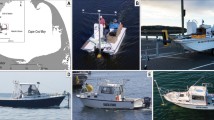Abstract
The Marine Physical Laboratory of the Scripps Institution of Oceanography has developed an acoustic relay transponder for precise relative positioning of near-bottom instruments and geologic sampling devices. Although specifically designed to position equipment lowered on standard wire ropes without a need to maintain direct electrical contact with the surface ship, the relay transponder may be used to track free vehicles, such as deep submersibles, from the surface. The relay transponder is positioned relative to an array of bottom-anchored acoustic transponders. It is interrogated acoustically from the surface ship; it then sequentially interrogates the bottom transponders which, in turn, reply to the ship. From the measurement of the total travel time (ship to relay transponder to bottom transponder to ship) and assuming, or knowing, the sound velocity of the water, we obtain a relayed range measurement. These relayed ranges, used in conjunction with ship to bottom-transponder ranges, allow us to calculate the position of the relay transponder. A recent application of this technique is described in which several gravity core samples from the crest of the Horizon Guyot were positioned with respect to the detailed bathymetry and the geology within the area. The estimated error in positioning the samples is less than 20 m inside a navigational net extending over 100 km2.
Similar content being viewed by others
References
Boegeman, D. E.: 1970, ‘The Offset Method of Sonar Ranging’, J. Institute Naviation 17, 47–51.
Lonsdale, P., Normark, W. R., and Newman, W. A.: 1972, ‘Sedimentation and Erosion on Horizon Guyot’, Bull. Geol. Soc. Am. 83, 289–316.
Lowenstein, C. D.: 1966, ‘Computations for Transponder Navigation’, Proc. Nat. Marine Navigation Meeting, 305–311.
Lowenstein, C. D.: 1968, ‘Position Determination near the Sea Floor’, in Marine Sciences Instrumentation 4, Plenum Press, New York, pp. 319–324.
Lowenstein, C. D. and Mudie, J. D.: 1967, ‘On the Optimization of Transponder Spacing for Range-Range Navigation’, J. Ocean Tech. 1, 29–31.
McGehee, M. S. and Boegeman, D. E.: 1966, ‘MPL Acoustic Transponder’, Rev. Sci. Instrum. 37, 1450–1455.
Mudie, J. D.: 1970, ‘Taking Computers to Sea’, in Marine Technology 1970 1, Marine Technology Soc., Washington, D. C., pp. 185–188.
Olsen, W. L.: 1971, ‘Use of Deep Tow to Survey a Submerged Wreckage’, SIO Ref. 71-14, 13pp.
Reid, J. L. Jr.: 1969, ‘Preliminary Results of Measurements of Deep Currents in the Pacific Ocean’, Nature 221, 848.
Spiess, F. N. and Mudie, J. D.: 1970, ‘Small Scale Topographic and Magnetic Features’, in The Sea 4, Part I (ed. by A. E. Maxwell), Interscience, New York, pp. 205–250.
Spiess, F. N., Grow, J., Luyendyk, B. P., and Mudie, J. D.: 1970, ‘Seven Tow, Leg 8, Cruise Report’, SIO Reference 70-31, 7pp.
Spiess, F. N. and Sanders, S. M.: 1971, ‘Survey of Chase Disposal Area (Nitnatow)’, SIO Reference 71-33, 20 pp.
Author information
Authors and Affiliations
Additional information
Contribution of the Scripps Institution of Oceanography, new series.
Rights and permissions
About this article
Cite this article
Boegeman, D.E., Miller, G.J. & Normark, W.R. Precise positioning for near-bottom equipment using a relay transponder. Marine Geophysical Researches 1, 381–396 (1972). https://doi.org/10.1007/BF00286740
Received:
Revised:
Issue Date:
DOI: https://doi.org/10.1007/BF00286740




